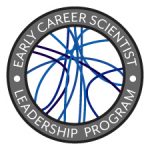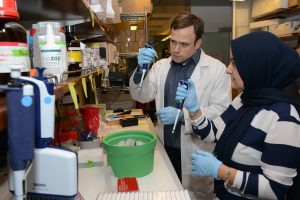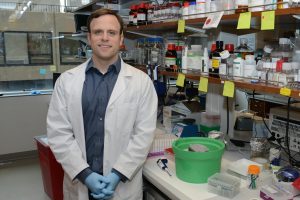 Chris Mason, Associate Professor at Weill Cornell Medicine, talks about revolutionizing academic research by setting a 500-year survival plan, harnessing the power of citizen scientists, crowdfunding, and creatively using genetics expertise across disciplines.
Chris Mason, Associate Professor at Weill Cornell Medicine, talks about revolutionizing academic research by setting a 500-year survival plan, harnessing the power of citizen scientists, crowdfunding, and creatively using genetics expertise across disciplines.
In the Decoding Life series, we talk to geneticists with diverse career paths, tracing the many directions possible after research training. This series is brought to you by the GSA Early Career Scientist Career Development Subcommittee.
Chris Mason contributes to an interplanetary survival plan based on multi-level, integrated Next Generation Sequencing data to understand tumor evolution, genome regulation, DNA and RNA modifications, and genome/epigenome engineering. He is a metagenomicist; he uses genomics to study all the organisms of the environment, including New York City (PathMap, Meta-SUB) and NASA’s international space station, thus giving us insight into the beneficial and less scary side of microbes and how they might influence the next 500 years of human existence. His work extends beyond academic research as he is the founder of several companies including Genome Liberty and the Pillar Health, which are personalized genomics companies to democratize access to genetic information, as well as Biotia, which brings machine-learning to map DNA and pathogens as they emerge in hospitals to predict their next move and to prevent hospital-acquired infections (HAI).
Did you ever see yourself as a metagenomicist of the Earth and beyond?
I learned in middle school about the awesome power of the information contained in a single cell. This innate information can lead to the genesis of all other cells, including a cell’s response to disease, and a wide range of traits about a person. It is a beautiful fact of life. My fascination with the genetic code led me to pursue a career as a human geneticist. As I learned more about microbiomes and other genomes around us, I started to imagine the world around us like Neo in the movie The Matrix where he could see the code embedded in the world. The visuals of The Matrix expanded my curiosity from human genetics alone to the whole interplay of all the genomes from cells, fragments of plant, bacterial, viral, animal, and human DNA and RNA molecules interacting constantly. Then I thought: what if we actually tried to understand all that using systems biology approaches? I have always been interested in space too, so I combined what I love about humanity, living in space, and long-term plans for humans using genomics—because it is the inevitable next step for our species as well as those around us!
Your work made me think of my germaphobe friends who take the subways often. Should we be concerned about microbes?
Generally, you don’t have to worry: the subway is safe. If you practice basic common sense, the odds are very good that you will never come across anything that will do harm. Data from projects like Meta-SUB consortium will lead to geo-spatially informed decisions on optimal routes, giving you the least susceptibility to disease or perhaps the most interactions with the microbes that you need in your immune system and current microbiome. Though our knowledge about the microbiome is still evolving, I envision that it won’t just be about avoiding microbes, but will also include customizing your routes to work and medicine to give you the best microbes you might need. This is likely 10-15 years away.
Your optimism for a successful futuristic society led to a five hundred year survival plan. Tell us how it came about.
We are the only species that is aware of our own extinction, and that gives us a right and a responsibility to protect ourselves, the things in us, and the things around us. It is helpful to plan this optimism through the lens of a long-term, or five hundred year plan. It seemed like a logical conclusion, to look at the universe and know that all of this human progress, scientific knowledge, art, music, poetry, and all human endeavors will go away unless we as a species preserve and protect it. The specifics of the five hundred year survival plan are divided into to ten phases, which start by completing the functional annotation of the human genome and identifying important genes that can or can’t be changed—what I call the “do not disturb list.” This sets the stage for identifying and introducing new gene variants and studying their effect on humans—a prerequisite for human engineering, testing survival in space, and the eventual settlement in new worlds. Surprisingly, things that sounded hard in that plan a few years ago now seem easy, especially with the advent of CRISPR technology.
Tell us about the people who helped you transform your curiosity into a career.
My mentorship started during my undergraduate years after I read an article in the student newspaper. I emailed professor Max Lagally asking if I could do a summer internship on using DNA to do high scale computation. Both Max and Lloyd Smith became my mentors despite being in different departments than mine. I learned from them that if you tell a student that you believe that he or she is smart and capable of discovering great things, that person suddenly feels that they can do great things, even if they didn’t before — or at least I did. The simple belief that they can discover great things will help them accomplish their goals. I try to take a similar approach with my own students.
Your work involves a lot of international collaborations. How can early career scientists participate in projects with contributors located around the globe?
My advice would be to just start something! You would be amazed by how many people will help you, and how easy it is today to get connected with social media. Graduate students and postdocs can engage with each other using online communities like Snapchat, Twitter, and blogs, and work with each other online to establish international consortia while also using crowdfunding to support their research. Another possibility are citizen scientists that facilitate international and multidisciplinary projects that are literally impossible to do as one lab or university or country. They necessitate the interaction and coordination of hundreds or thousands of people, in some cases. Citizen scientists enable new science, engaging people and crossing disciplines, boundaries, and cultures. You have to also learn to be humble and collaborative. You need to swallow your pride and understand that this is all of us working together on a global project.
Are there any specific experiences you’ve had as a professional that have shaped your career?
I was an expert witness during the Myriad case against gene patenting during my postdoctoral fellowship, and it had a big impact on my career. What are the genetics rights that you have? Can you modify or “discover” your DNA? I wrote several declarations for the case, which were cited by the courts and even helped us win won 9 to 0 in the U.S. Supreme Court. The biggest lesson from that case was that if you really believe in something and you work hard, you might actually be right and can win in the end, even if it takes six to seven years with everyone saying that you are wrong.
This work inspired the establishment of Genome Liberty and Pillar, which are direct-to-consumer genetics and genomics companies that offers genomics services for improved health. Our goal is to raise awareness about genetic rights by helping patients learn more about their conditions and improve their health care by means of a participatory medicine paradigm.
What are some of the extracurricular activities that you enjoy?
I enjoy running, music, and I love to write. I am actually working on a book of genetics poetry, which will come out later this year. Spending time with my family is another one of my favorite things; the biggest problem I have is that I love both my family and my work, but my daughter is too young to help in the lab… at least for now.
About the author:
![]() Faten Taki is the Liasion for the Early Career Scientist Career Development Subcommittee and a postdoctoral associate at Weill Cornell Medical College. Her goal is to be able to give back to the scientific community while still growing as an early career scientist.
Faten Taki is the Liasion for the Early Career Scientist Career Development Subcommittee and a postdoctoral associate at Weill Cornell Medical College. Her goal is to be able to give back to the scientific community while still growing as an early career scientist.
Learn more about the GSA’s Early Career Scientist Leadership Program.















